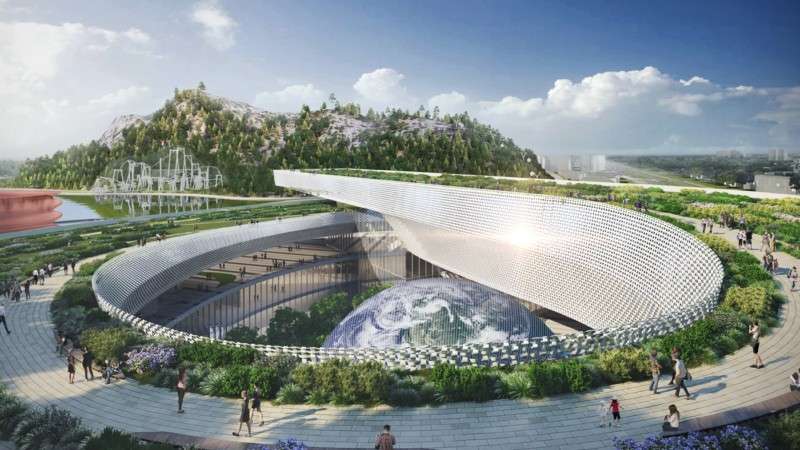Global architecture firm Perkins+Will will design the Suzhou Science & Technology Museum, the centerpiece of a new cultural district in Shishan Park, about 62 miles northwest of Shanghai. With its terraced landscapes and flowing design, the new 600,000–square-foot museum is inspired by the Chinese expression of shan sui, which roughly translated means the union of mountain and lake. Located at the foot of Lion Mountain and next to Shishan Lake, the museum also will include a 66,700-square-foot industrial exhibition hall, where exhibits will highlight the role of industrial development in enriching lives.
The Science & Technology Museum is Perkins+Will’s most recent civic and cultural project in China following the Shanghai Natural History Museum, which earned international accolades after its opening in 2015.
“We are thrilled to have the opportunity to design the new Suzhou Science & Technology Museum,” said Ralph Johnson, Global Design Director of Perkins+Will. “Our design recognizes the importance of Suzhou in China’s commercial history, and underscores its role at the forefront of China’s emergence as a technology leader and innovator. The museum also draws inspiration from the natural environment surrounding it.”
The museum concept melds the city’s heritage as a major trading center on the Yangtze River – sometimes known as “the Venice of the East” – with a contemporary look that reflects the city’s current wave of innovation. It’s ribbon-like form emerges from the base of Lion Mountain, twisting upward and turning back on itself to cantilever out over the edge of Shishan Lake and an archipelago of small islands to reengage the mountain. This form creates an iconic infinity loop–an enduring symbol of prosperity–with the metallic facades evoking a flowing silk scarf, one of Suzhou’s most coveted exports. The lake itself will include several man-made, teardrop-shaped, planted Eco Islands, connected by walkway to the museum and serving as both a filtration system for the lake as an opportunity for environmental exploration and education.
SLIDESHOW:
Among other key design features:
• Visitors can arrive at the museum from several approaches. Those coming by subway will be guided into the museum along a shallow ramp to the circular promenade that surrounds the park. Visitors arriving by car or bus will enter through the “Discovery Court,” a formal plaza with reflecting pools and gathering spaces, offering a glimpse of what lies inside. Just inside the entry sits a signature feature of the museum – a three-story atrium adjacent to a sunken water-filled courtyard that includes several small planted islands, recalling the Eco Islands in Shishan Lake.
• With the lower levels providing numerous access points, guests can enjoy all or a select number of exhibitions, with all levels within the museum having access to natural daylight.
• At the museum’s apex on the third level is “Lion Mountain Terrace” which stretches out over the Eco Islands in Shishan Lake, framing Lion Mountain in the distance.
Sensitivity to the surrounding environment is a hallmark of sustainability in the new museum:
• The “Life-Giving Forest” outside provides an air filtration buffer to the city, plus a respite from the sun, space for movement and gathering, and opportunities to explore educational exhibits.
• At the base, where the museum meets the lake, public pedestrian walkways winding through the wetlands and Eco Islands become outdoor learning environments with signage guiding children and adults to explore water purification, storm water management, and sustainable living.
• The museum’s three-dimensional metal mesh skin that transitions from opaque to transparent will control daylight and solar gain to protect sensitive exhibits. The skin also allows interior light to filter through the façade at night, creating a soft shimmering glow that dynamically changes as visitors circulate around the building.
• Civic plazas are designed with permeable paving systems, and bioswales allow rain water to percolate directly into the ground or be directed toward the planted vegetation to be filtered naturally. Green roofs mitigate heat island effect and capture storm water to create habitats rich with flora and fauna.
• Water restoration strategies – construction of wetlands, the design of a small archipelago of water filtering gardens – will improve the water quality of Shishan Lake, making it a healthy habitat for wildlife as well as a safe place for visitors.
The Suzhou Museum aims to draw visitors from all over China and beyond, celebrating history and inspiring scientific learning and exploration for a new generation. In an unending loop – from the promenade embracing the park, the park embracing the mountain, and the mountain embracing the new building – the Science & Technology Museum will create an experience of infinite harmony between nature, technology, and urban life to shape, influence, and enrich people’s lives.






